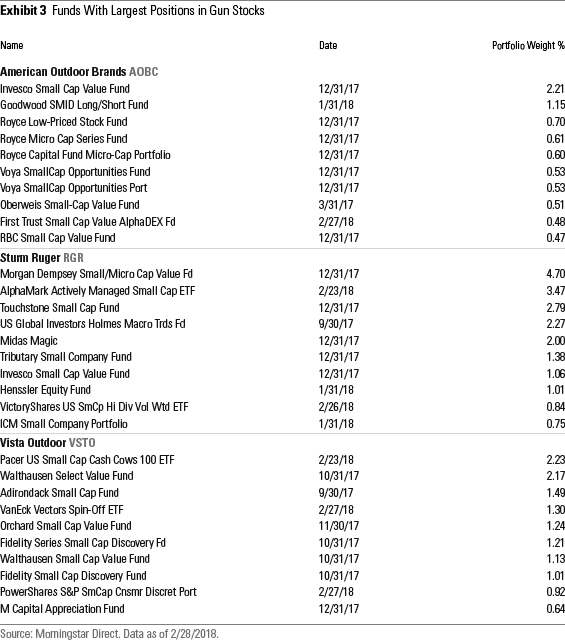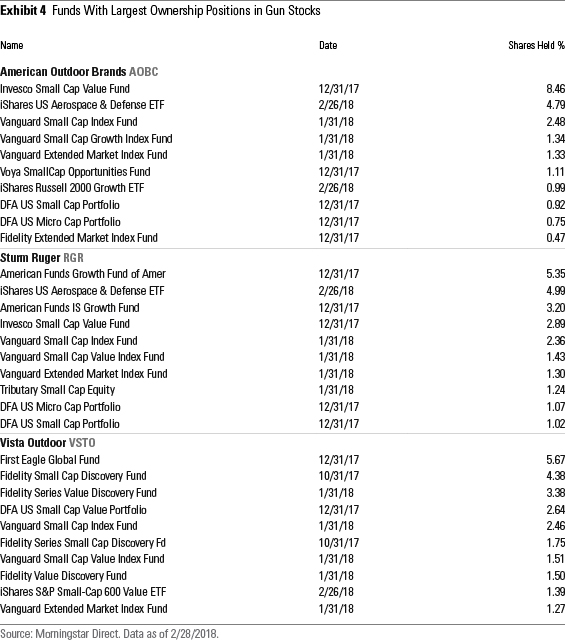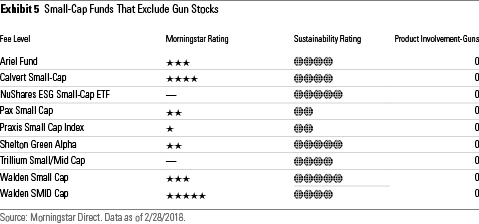Finding Gun Stocks in Fund Portfolios
And why asset managers should be engaging with gunmakers.
they
As a mutual fund investor, you may be wondering whether any of your funds are invested in gun manufacturers like American Outdoor Brands AOBC, which made the AR-15 used in the Parkland, Florida massacre of high school students. Two other publicly traded companies also make versions of the AR-15: Sturm Ruger RGR and Vista Outdoor VSTO. Here's how to find out whether your funds are invested in these companies and some things you can do about it.
Do You Own Small-Cap Stocks? The first question to ask yourself is whether you own a mutual fund with exposure to U.S. small-company stocks. If the answer is yes, that is, of course, a good thing from a diversification standpoint. But it does mean you may be invested in guns, because the publicly traded gunmakers are all small-cap stocks.
Using a feature in Morningstar Direct called Ownership Detail, I generated a list of funds invested in American Outdoor Brands, Sturm Ruger, and Vista Outdoor. I also used our Product Involvement screen in Direct, with data provided by Sustainalytics, to check for exposure to gun stocks.
The results: Driven by assets in index funds, approximately two out of every three dollars invested in small-cap funds have exposure to guns. That exposure is spread across 264 open-end funds and exchange-traded funds. American Outdoor Brands is owned by 197 funds, Sturm Ruger by 252 funds, and Vista Outdoor by 234 funds. Many funds own two or all three of the stocks. About 400 funds have no exposure, virtually all of them actively managed funds, but they don't have as many assets as the group of funds with exposure to guns.
Do You Own Small-Cap Stocks in an Index Fund? If you get your small-cap exposure through an index fund, you are sure to be invested in at least one of the gunmakers and probably all three, depending on the index your fund attempts to replicate. In addition to being in small-cap indexes, these firms are included in total-stock-market index funds, which provide one-stop exposure to the entire market, and in extended-market index funds that are typically paired with core large-cap index funds.
Exhibit 1 shows the gun stock exposures of total-market and extended-market indexes with assets of more than $1 billion. The 11 total-market funds follow six different indexes, all of which have exposure to all three gun stocks. Because

(Download full exhibit)
Exhibit 1 also shows the gun stock exposures of extended-market indexes with more than $1 billion in assets. In effect, these indexes comprise small- and mid-cap stocks, and the individual gun stock positions are about 0.02% each.
Exhibit 2 shows the gun stock exposures of small-cap index funds with assets of more than $1 billion. These 28 funds follow 13 different indexes. Gun stock exposures range from 0.06% in the CRSP US Small Cap Index used by

(Download full exhibit)
Do You Own an Actively Managed Small-Cap Fund? If you get your small-cap exposure through an actively managed fund, you have a better chance of not being invested in any of the three gunmakers. That's because, compared with index funds, actively managed funds hold far fewer names in their portfolios, all of which a given portfolio manager believes will outperform the market. With thousands of small companies from which to choose, only some managers are likely to select any of the gun stocks for their portfolios.
To check your fund's exposure, you can refer to this list of funds that have positions in any of the three gun stocks, according to the funds' most recent publicly available portfolios. Otherwise, you can find this information on your own, but it can be a tedious process. You can find a fund's 25 largest holdings on Morningstar.com. If you are Premium member, you can see a fund's 100 largest holdings. Because the gun stock exposure of most funds is often a small position, though, it may not be included in the top-25 or top-100 lists. You can find a fund's full portfolio holdings in its most recent shareholder report, available on Morningstar.com by going to a fund's Quote page, clicking on Filings, and then clicking on the Annual or Semi-Annual Shareholder Report, or you can go directly to the fund's website.
What Funds Have the Largest Positions?
Exhibit 3 shows the funds with the largest portfolio weightings in each gun stock.

Exhibit 4 shows the funds that hold the largest number of shares in each of the three gunmakers. This metric is driven more by the asset size of the funds than by the size of their portfolio weightings in the stocks. Invesco Small Cap Value holds a significant 8.5% of American Outdoor Brands shares, and three Vanguard index funds hold a total of 5.15%.

To summarize, the only way to avoid gun exposure is via actively managed funds. If you do have exposure through an actively managed fund, chances are it's a modest position. If you get small-cap exposure through index funds, you are sure to have some exposure to gun stocks. That exposure is tiny, though. So tiny, in fact, that these stocks cannot have a material impact on your investment returns.
Given the de minimus impact on investment returns, most index investors can rest easy knowing they are not invested in guns in a material way. But for many, that's not the point. Any exposure to guns may no longer be acceptable. While it's easy to find good funds among the 400 that do not have exposure to gun stocks, few actively managed funds carry any kind of guarantee that they will never invest in guns. Exhibit 5 is a too-short (and probably not comprehensive) list of small- and mid-cap funds that do not invest in guns or other types of weapons manufacturers as a matter of investment policy. Most of these are on the list of sustainable funds that I detailed in a recent column.

Is My Asset Manager Engaging With Gunmakers? There is one other question to ask, especially if you are an index investor--does the asset manager intend to engage with gunmakers on the safe and responsible use of their products? It is certainly a fair question.
Because you and so many others have purchased low-cost index funds, those funds have amassed a huge amount of assets. When they buy even a tiny position in a small-cap stock, they are gobbling up a significant number of shares in the company. That's why index funds feature so prominently in Exhibit 4 above. At more than $700 billion in assets,
As stewards of your capital and as major shareholders in the three gunmakers, these asset managers have an obligation to engage with company management about their response to the Florida shootings, issues surrounding the safe and responsible use of their products, and their lobbying activities.
BlackRock and State Street have already signaled their intent to do so. A spokesman
that BlackRock "will be engaging with weapons manufacturers and distributors to understand their response to recent events." According to
, State Street has also said it will be engaging with weapons makers and distributors "to seek greater transparency from them on the ways that they will support the safe and responsible use of their products" as well as monitoring the firm's lobbying activities. It's particularly notable that both firms indicated they would also engage with gun distributors, which implies conversations about guns with larger retail companies that sell guns like
that it would no longer sell assault rifles or high-capacity magazines and would raise the required age for a gun purchase to 21.
Vanguard and Fidelity apparently don't see it that way. A Vanguard spokesman told Barron's, "We believe it would be exceedingly difficult to manage our funds effectively and efficiently while seeking to address the many social, political, and environmental concerns of 20 million clients." For its part, a Fidelity spokesman told Reuters this week that "the firm generally does not comment on individual companies or how it plans to vote on proxy resolutions."
As long-term permanent investors, giant asset managers like these have a stake in maintaining and strengthening the broader social systems within which they invest, because over the long-run, healthy systems create the conditions for better investment returns. Thus, their engagement activities should be oriented toward systemic issues that affect subject companies materially and that the companies can play a role in helping address more broadly. The misuse of guns has spillover costs on many other companies that they hold in their portfolios, as well as on society at large. Significant engagement with gunmakers at this point should be an obligation.
Jon Hale has been researching the fund industry since 1995. He is Morningstar’s director of ESG research for the Americas and a member of Morningstar's investment research department. While Morningstar typically agrees with the views Jon expresses on ESG matters, they represent his own views.

/s3.amazonaws.com/arc-authors/morningstar/42c1ea94-d6c0-4bf1-a767-7f56026627df.jpg)
/cloudfront-us-east-1.images.arcpublishing.com/morningstar/CFV2L6HSW5DHTFGCNEH2GCH42U.jpg)
/cloudfront-us-east-1.images.arcpublishing.com/morningstar/7JIRPH5AMVETLBZDLUSERZ2FRA.png)
/cloudfront-us-east-1.images.arcpublishing.com/morningstar/YWKBIVULT5DGJEIGAJGBA6H5ZA.png)
:quality(80)/s3.amazonaws.com/arc-authors/morningstar/42c1ea94-d6c0-4bf1-a767-7f56026627df.jpg)